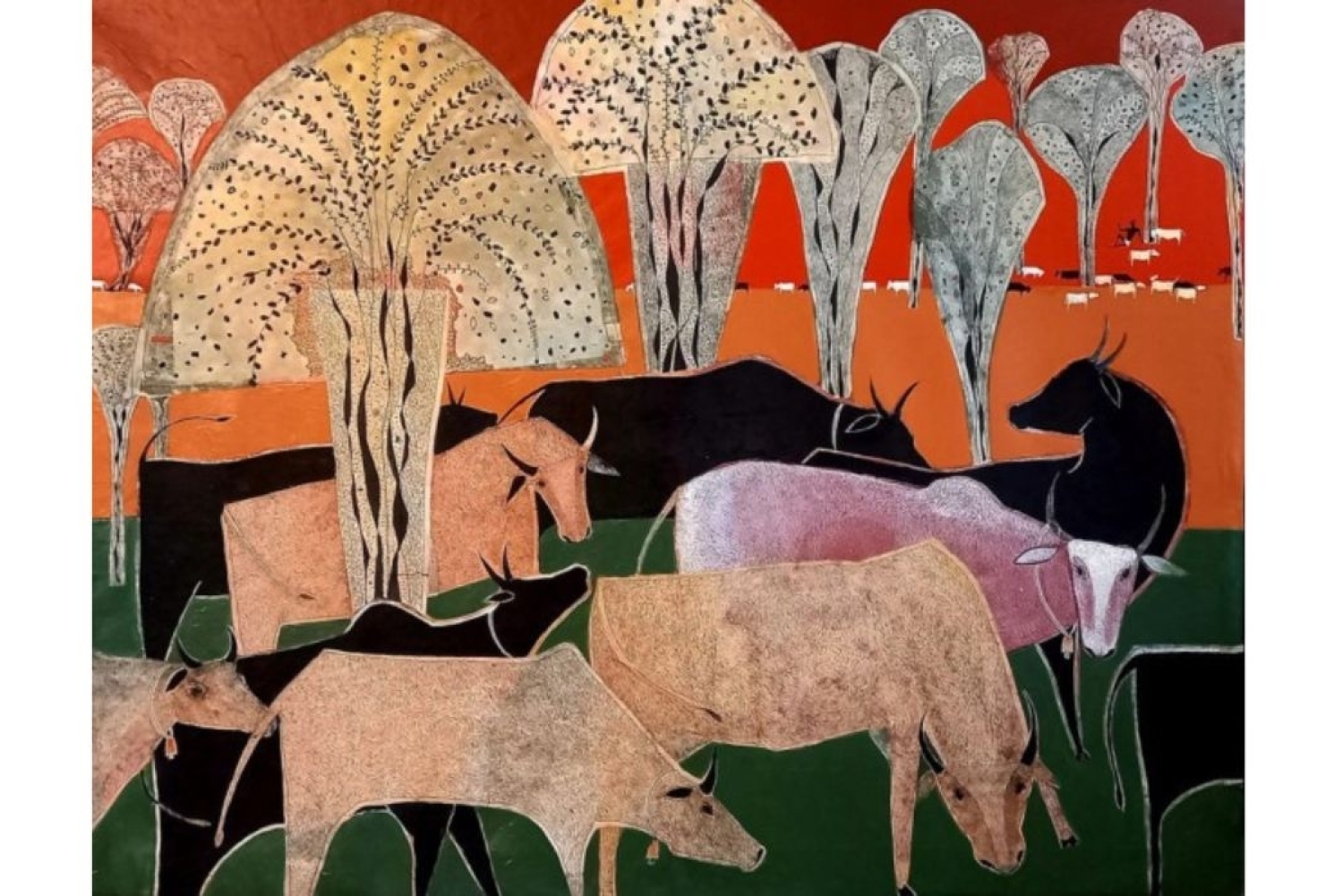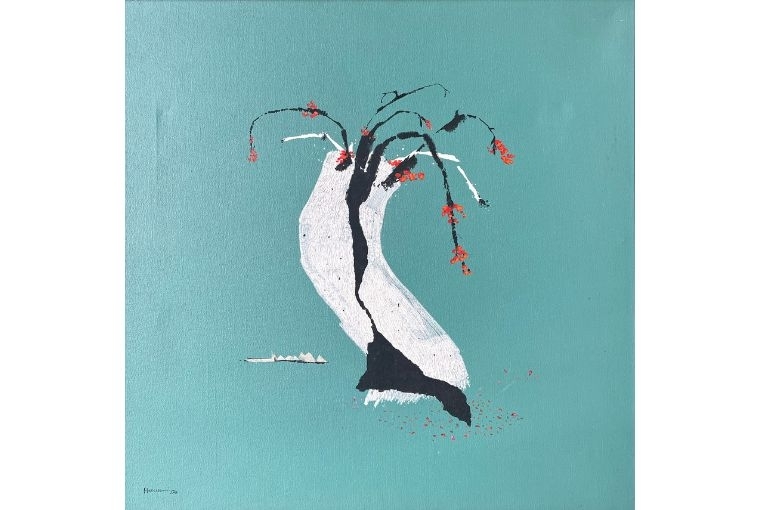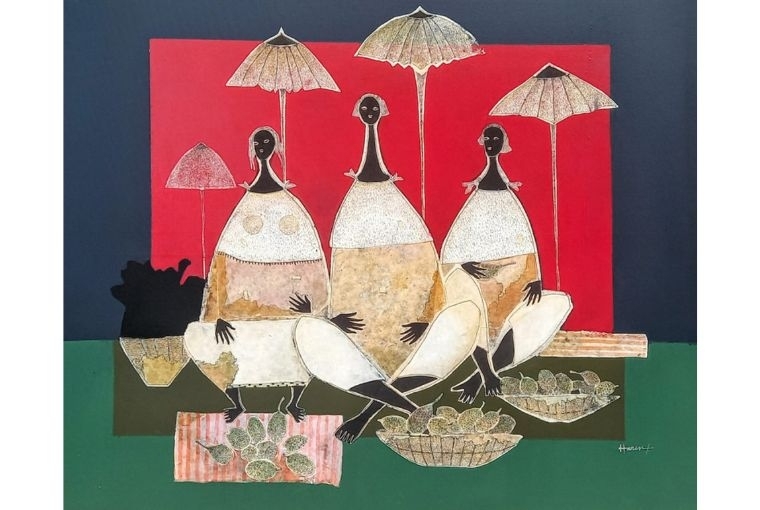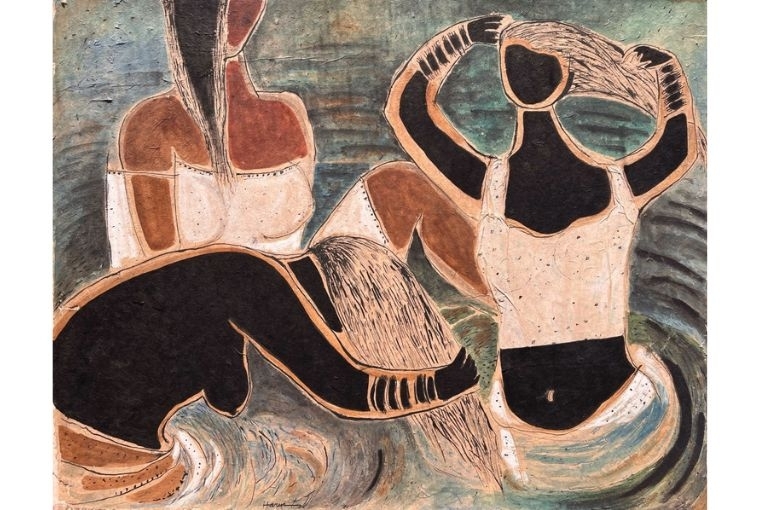
Godhuli (Cows returning Home in the evening)_Mixed media on canvas_36 x 46 in_2020

Godhuli (Cows returning Home in the evening)_Mixed media on canvas_36 x 46 in_2020
A Moment in Modernity, a landmark solo exhibition of works by artist Haren Thakur, curated by celebrated art historian Dr. Alka Pande. Haren Thakur is recognized as a modernist artist whose work intricately weaves together traditional tribal art forms with contemporary aesthetics. His art reflects a deep engagement with nature, life, and spirituality, often depicting themes of harmony and simplicity through a fusion of tribal and modern elements.
'He attributes qualities such as love, empathy and camaraderie to trees, seeing them as silent witnesses to human existence. This perspective aligns with his broader artistic goal: to capture the spontaneity and rhythm of life, rejecting polished artificial refinement in favour of organic movement and energy. His work reflects a deep commitment to preserving authenticity, ensuring that art remains a medium for genuine expression rather than mere aesthetic sophistication.'-Dr. Alka Pande, Curator

Palash Mixed Media on Canvas 24” x 24_ 2015
He was educated at Kala Bhavana, Visva-Bharati University in Shantiniketan, where he studied under some of the most influential figures in modern Indian art, including Ramkinkar Baij, Benode Behari Mukherjee, Somnath Hore, and Dinkar Kaushik. Deeply rooted in the humanist and indigenous traditions of Indian modernism, the environment encouraged the young Haren to engage directly with nature, rural life, and vernacular artistic practices. These values became central to Thakur’s artistic philosophy, which continues to inform his work today.
At Santiniketan, he absorbed the ideals of contextual reinterpretation and Eastern modernism, which emphasized an organic relationship between art and its surroundings. The teachings of his mentors instilled in him a deep appreciation for the rhythms of nature and the lived experiences of tribal communities—an approach reminiscent of Ramkinkar Baij’s sculptural depictions of Santhal tribals and Benode Behari Mukherjee’s mural compositions. Somnath Hore’s socially charged, textured works also left a lasting impact, shaping Thakur’s sensitivity toward themes of labor, resilience, and cultural memory.
Haren set up his studio in Jharkhand in 1974, where he continues to live and work. His engagement with the region’s tribal communities and landscape has reinforced his commitment to preserving indigenous narratives while adapting them to contemporary artistic discourse. His work bridges historical memory with modern concerns, urging audiences to recognize the richness of local traditions before they are lost to rapid development and urbanization. Throughout his career, Thakur has remained deeply connected to the legacy of Santiniketan’s humanist art tradition while forging his path as a modernist.

Vegetable Sellers Mixed Media on canvas 36” x 48” 2024
“Haren Thakur touches upon the primal essence of life in the most warm and humane manner. The simplest acts of living and the human-animal bond find artistic expression that reveals the holistic unity of Man and Nature”. -Renu George, Director - Gallery Time & Space.
Thakur decided to stick with the eastern forms of Modernity style from Bengal, Bihar and Orissa. He started relooking at the Renaissance set up by Rabindranath Tagore at Santiniketan and created his own unique language. A closer examination of Haren Thakur’s watercolour artwork, Cat and the Fish, reveals a profound connection to Bengal’s cultural landscape. The image of a cat holding a fish in its mouth beside a fish pond is more than a simple representation—it reflects the cultural imprint of his time in Santiniketan and the lasting influence of Bengali traditions on his artistic sensibilities.
Thakur also favours Nepalese rice paper as his primary medium for his acrylic and watercolors works, a material he has been using since 1974. His brushwork is fluid, capturing motion and musicality, something he associates with tribal speech and movement. His figures often blend into their surroundings, emphasizing a seamless relationship between humans and nature.
Thakur’s approach to modernism is deeply rooted in Eastern aesthetics and Indigenous materials, echoing the ideals of Santiniketan artists who sought alternatives to Western artistic conventions. By incorporating Nepalese rice paper into his works, he not only preserves artisanal heritage but also reinforces his commitment to a distinctly Indian modernist visual language that remains grounded in cultural authenticity.

Three Bathers Mixed Media on Paper 20” x 26_ 2000
'Haren Thakur’s works reminisce about the time of the Indian Renaissance. The modernistic approach conjoined with his own interpretation of his surroundings and environment creates a powerful language which is original and unique.' -Saurabh Singhvi, Director, Art Magnum.
Thakur's studies of Egyptian wall paintings, particularly from the Thutmosis IV era, inspired him to integrate their geometric sophistication into his visual language. This influence is evident in his stylized human figures and structured compositions, where the formal precision of ancient Egyptian art is reinterpreted within a modernist framework.
His work embodies a fusion of tradition and modernity, where he reshapes living artistic traditions into an evolving visual language. Rather than merely preserving folk art, he transforms it, merging diverse influences in a continuous process of reinterpretation. His practice transcends conventional boundaries, resulting in a visual philosophy that embraces abstraction and reinvention while maintaining a reverence for cultural heritage.
Thakur’s visual language is deeply influenced by Munda and Birhor rock art, which he reworks and experiments with, rather than simply replicating. Over time, his artistic practice moved beyond a strict adherence to Jharkhand’s folk art, evolving into a more versatile and contemporary form. This led to the development of a geometric visual language, incorporating elements of Warli art and Cubism, demonstrating his ability to synthesize traditional motifs with modernist abstraction.
Thakur draws significant inspiration from his environment, particularly the intricate details of rural life. His works often reflect the harmony and rhythm of village existence, where life remains untouched by external disruptions. His flat-surfaced compositions enriched with bold earthy tones highlight his connection to fundamental artistic elements. Being of Bengali descent, his art also engages with Eastern Indian visual traditions. Through techniques of cutting, molding, pasting, and painting, he transforms this fragile yet resilient material, exploring themes of earth, agrarian life, and ecological concerns.
His paintings depict themes from tribal life but are not merely documentary in nature. Works like ‘The Musical Meet’ portray couples in an intimate yet timeless way, inviting comparisons to mythological figures such as Shiva-Parvati or Rama-Sita. The Open Parlour highlights intergenerational care, a practice he feels is disappearing in urban society. Meanwhile, The Reckless Recluse presents a man at ease after drinking, challenging the notion that guilt and excess are exclusive to urban life.
Thakur’s deep immersion in the tribal communities of Jharkhand profoundly shaped his artistic vision, allowing him to experience first-hand their harmonious relationship with nature. This exposure led him to incorporate tribal symbols and imagery into his work, bridging the gap between traditional and contemporary art forms. His art does not merely depict tribal life but engages with its deeper cultural and philosophical essence, presenting it as an enduring source of wisdom and aesthetic richness.
Like his teacher Ram Kinker Baij, a strong theme in Thakur’s work is often projected through a tribal lens. While his art incorporates religious and mythological imagery, it does not function as a direct representation of these narratives but rather as an exploration of their cultural ethos. His approach to simplify the abstractreligious iconography allows him to infuse his own spiritual perspective, moving beyond traditional depictions to craft and a more personal and introspective visual language. Thakur views tribal life not as primitive or outdated but as a source of deep wisdom and aesthetic richness. He believes that contemporary society has lost touch with its roots and that the so-called “civilized” world is often less connected, emotionally and socially than tribal communities. His works emphasize both the distinctiveness and universality of indigenous cultures, highlighting how their traditions resonate with broader human experiences.
Nature, in Thakur’s artistic philosophy, is not a passive backdrop but a living entity, imbued with emotions and symbolic meaning. He attributes qualities such as love, empathy, and camaraderie to trees, seeing them as silent witnesses to human existence. This perspective aligns with his broader artistic goal: to capture the spontaneity and rhythm of life, rejecting polished artificial refinement in favour of organic movement and energy. His work reflects a deep commitment to preserving authenticity, ensuring that art remains a medium for genuine expression rather than mere aesthetic sophistication.
Exhibition Dates: May 4 - June 30, 2025 | August 5 - 11, 2025 Venue: Visual Arts Gallery, India Habitat Centre, New Delhi | Art Magnum, 60/2c, Sri Aurobindo Marg, New Delhi | Jehangir Art Gallery, Mumbai
Date 7.05.2025